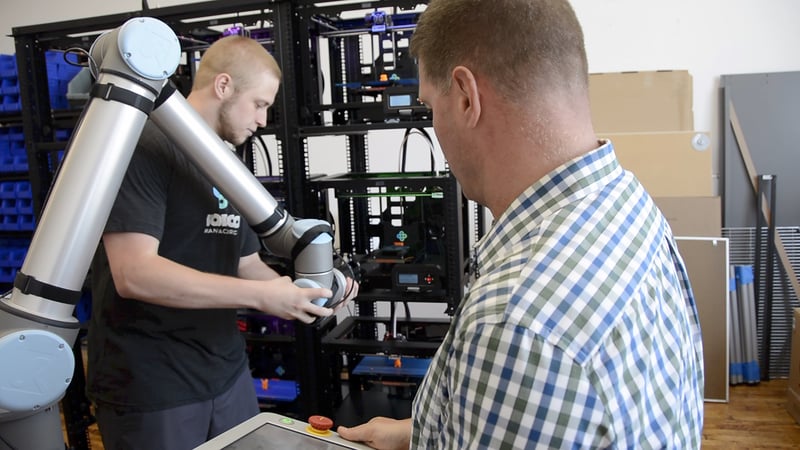How to Ensure Robotics Training Delivers Results

Posted on Jun 06, 2018 7:00 AM. 5 min read time
Why do training programs fail? All too often, well-intentioned training programs don't deliver results. Here's how to ensure your robotics training is effective.
We invest in training because we want to produce a change in our business. Whether we want to increase manufacturing output, improve customer satisfaction, or develop more innovative products, we usually choose training with an end goal in mind.
Why might a training program fail to deliver results? While some reasons may be beyond our control, most of them can be traced back to the initial implementation of the training program.
Developing a proper training program is essential for the growth of your employees.
Five reasons why training programs fail
There are many factors that cause training to fall short, but the five most common reasons come up time and again:
- Lack of alignment with business needs—Your robotics training program should be aligned with the long-term goals of your business. Training fails when there is no clear connection between training outcomes and business growth—in other words, avoid training for training's sake.
- Lack of specific direction and focus—Each individual training activity should have a specific focus. For example, in robotics it can be more effective to train with a particular application or process in mind. Without this focus, it is harder for employees to apply the knowledge directly to their day-to-day job, which makes for less effective learning.
- Lack of monitoring—As we discussed recently, "what gets measured gets done." Monitoring is an active process, especially because the effects of training are often intangible. It's important to implement metrics from the start and monitor them throughout the training program.
- Lack of accountability—The success of a training program is as much the responsibility of employees as it is of management. Training programs often fail to deliver results when trainees do not personally commit to making a change. This can happen when the goals or content of the training program are not aligned with their own needs or jobs.
- Failure to gather and use feedback—Two-way feedback is the key to making both learning and training more effective. Training is not a "set it and forget it" activity. Training programs can fail to deliver when trainees don't receive adequate feedback from instructors. Plus, feedback from trainees is essential for improving the program over time.
Of the five reasons, the final one is probably the most important. You can iron out any problems in a training program as long as you gather feedback effectively and work on continuous improvement.
But let's say you're just getting started. How can you implement your robotics training program correctly from the start?
The simple process for ensuring effective training
Here at Robotiq, we want to make it as easy as possible for you to start training your own team of in-house robotics experts.
That's why we've created a series of eBooks to help you out. We've taken key business skills and applied them to robotics.
The result is a clear, straightforward process you can apply to your own business right away.
The eBooks are arranged into 10 modules (starting with Module 1). Together they guide you through the whole process of developing a robotics team, from assessing your business needs, to implementing your training program, to measuring the effectiveness of the program.
Module 9 is available to download right now. This module is a hands-on worksheet that shows how to monitor the effectiveness of your training program to ensure it continues to align with your business needs.
First, design and launch your training program
If you haven't already, you should definitely check out the first eight modules (starting with Module 1). They provide a step-by-step guide through the whole process of implementing a successful robotics training program. They discuss how to assess the robotics needs of your business, get the team on board, and build an effective training program.
Next, gather feedback about training effectiveness
Module 9 guides you through the process of measuring a training program to ensure that it is effective and in alignment with your business goals.
The module uses Kirkpatrick's Four-Level Training Evaluation model, which we briefly introduced in "In-House Robotics Expertise: How to Tell If It's Working."
The worksheet shows you how to implement each of the four levels:
Level 1: Gather Trainee Reactions—Feedback forms are a rough measure of training effectiveness. Although limited, they're quick and easy to implement. The module provides a template you can use to construct your own feedback forms to measure trainees' reactions.
Level 2: Assess Learning Objectives—At this level, you compare what the trainees have learned with pre-defined learning outcomes. The activities at this level go along with the Individual Learning Plan, which was introduced in Module 7.
Level 3: Monitor Behavioral Changes—The true test of training effectiveness is whether it succeeds in changing employees' behavior. Did the training program turn knowledge into action? The module discusses a few options for objectively measuring this outcome.
Level 4: Measure Results—Ultimately, a training program is only effective if it succeeds in improving your business. Based on the metrics you chose in Module 8, you will measure how training impacts your business on an operational level.
By the end of this module, you'll have all the tools necessary to implement an effective robotics training program in your business.
Good luck!
Make sure to send us feedback about your experiences with the eBooks so we can improve them (just like how you'll use feedback to continually improve your robotics training program).
What have been the stumbling blocks for your training programs in the past? What has worked well – or not so well? How are you getting on with the modules? Tell us in the comments below or join the discussion on LinkedIn, Twitter, Facebook or the DoF professional robotics community.




Leave a comment